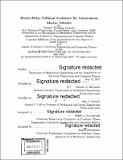Intent-aware collision avoidance for autonomous marine vehicles
Author(s)
Leavitt, Joseph William
DownloadFull printable version (30.68Mb)
Other Contributors
Massachusetts Institute of Technology. Department of Electrical Engineering and Computer Science.
Advisor
Michael R. Benjamin and John J. Leonard.
Terms of use
Metadata
Show full item recordAbstract
Applications of autonomous marine vehicles in dynamic and uncertain environments continuously grow as research unveils new enabling technology and academic, commercial, and government entities pursue new marine autonomy concepts. The safe operation of these vehicles in the marine domain, which is currently dominated by human-operated vehicles, demands compliance with collision avoidance protocol, namely the International Regulations for Preventing Collisions at Sea (COLREGS). Strict application of this protocol can lead to a highly constrained motion planning problem, in which it is difficult for a vehicle to identify a safe and efficient motion plan. This thesis proposes a multi-objective optimization-based method for COLREGS-compliant autonomous surface vehicle collision avoidance in which vehicles use shared intent information, in addition to vehicle state information, to identify safe and efficient collision avoidance maneuvers. The proposed method uses intent information to relax certain COLREGS-specified constraints with the goal of providing sufficient maneuvering flexibility to enable improvements in safety and efficiency over a non-intent-aware system. In order to arrive at an intent-aware solution, this thesis explores the concept of intent, including intent formulations for the marine domain, intent communications, and the application of intent to the COLREGS-compliant motion planning problem. Two types of intent information are specifically evaluated: COLREGS mode intent, in which the give-way vessel in an overtaking or crossing scenario communicates its intent to maneuver in a certain direction with respect the stand-on vessel, and discrete trajectory intent in which vehicles communicate projected future positions. Simulations and on-water experiments demonstrate the feasibility of the proposed intent-aware method, as well as improvements in performance, in terms of both vehicle safety and mission efficiency, over a non-intent-aware, COLREGS-compliant collision avoidance method.
Description
Thesis: Nav. E., Massachusetts Institute of Technology, Department of Mechanical Engineering, 2017. Thesis: S.M., Massachusetts Institute of Technology, Department of Electrical Engineering and Computer Science, 2017. Cataloged from PDF version of thesis. Includes bibliographical references (pages 259-278).
Date issued
2017Department
Massachusetts Institute of Technology. Department of Electrical Engineering and Computer Science; Massachusetts Institute of Technology. Department of Mechanical EngineeringPublisher
Massachusetts Institute of Technology
Keywords
Mechanical Engineering., Electrical Engineering and Computer Science.